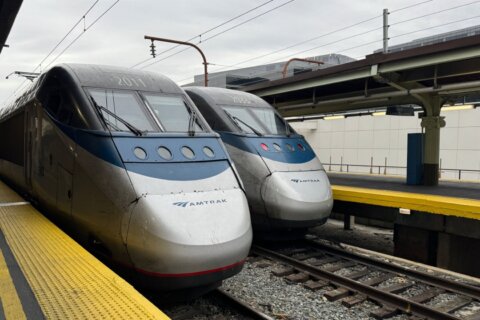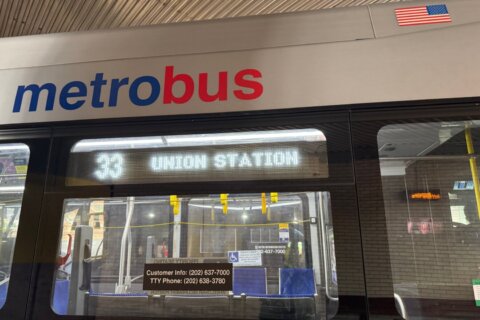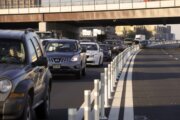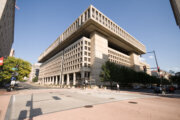Metro unveiled its initial budget proposal for the next fiscal year on Thursday — and it includes additional bus and rail service.
Changes include more peak-capacity service on Metrorail with longer operating hours on weekends. The rail map would also see some slight changes with half of northbound Yellow Line trains going to Greenbelt instead of turning around at Mount Vernon Square. Additionally, half of eastbound Silver Line trains would end at New Carrollton instead of Downtown Largo. It will also implement its redesigned bus network, which is set to go into effect in June.
A year ago, Metro was facing a $750 million deficit and was looking at having to make drastic cuts. D.C., Maryland and Virginia all pitched in additional funding to avoid that scenario, but Metro’s long term financial outlook still isn’t in the clear.
Meanwhile, Metro has taken a number of safety-related measures over the last few years, including putting uniformed officers on trains and cracking down on fare evasion.
On Sunday, the transit agency will begin bringing back automatic train operation for the first time since it was stopped after the 2009 Fort Totten crash. The reintroduction will start with just the Red Line before it’s expanded to other rail lines sometime next year.
Randy Clarke, Metro’s general manager and CEO, talked about it all with WTOP’s Shawn Anderson and Nick Iannelli.
The transcript below has been lightly edited for clarity.
Randy Clarke: Last year, we had a very significant issue. We still have a long term issue, and I think that’s really important — that probably about by 2029, give or take, our Capital funding, we’re going to hit a massive fiscal cliff. But with our partners last year, new contributions, and also we’ve identified about a half a billion dollars of savings in the last two years. We’ve really brought the operating budget in a much better state.
And so, we were able to propose a budget to the board that actually includes increasing service. And our demand is going up pretty significantly. We’re actually leading the country in ridership growth right now, so we’re getting a lot more calls to actually add even more service, and that’s what this budget reflects.
Nick Iannelli: You’ve been meeting with leaders from around the region over the past year to find sustainable funding for Metro. It’s been a persistent issue, obviously. Ideas like a regional sales tax or a gas tax have been thrown around. Do you have a preference on what might be a better funding model in the long term for Metro?
Randy Clarke: Well, one, I always say, it’s not my job. That’s the elected officials’ job, and it’s their communities to ultimately make those decisions, and we really appreciate their collaboration. The most important part is that everyone is unified. Everyone’s tired of talking about Metro’s funding over and over, in kind of a cut and paste model.
So what we need is sustainable and dedicated funding that is bondable and that is indexed. And a lot of work was done in 2018, 2019, for the Capital Program, but it was never indexed. And obviously, if you bought a fridge today, it costs a lot more than a fridge in 2019, and so we’ve lost that purchasing power from that money. And if we index things, kind of like Social Security, then we’re not going to have this problem going forward.
So the source itself is, I think the good policy discussion to have. The only one that I would comment on is, I think gas tax is not going to work. Because, as we know, gas tax is already a challenge in the entire trust fund, nationally and locally. And as the electric world moves forward, I think that’s going to become less of a source. So I think this policy discussion about what is the right source and how does it get balanced is really the big discussion for the next year or two.
Shawn Anderson: One thing that has made some people reluctant to return to Metro is the perception that there is a crime problem. You’ve had a number of efforts related to that, things like putting officers on trains, making fare evasion harder. Where would you say Metro is right now from a safety standpoint?
Randy Clarke: Listen, I get that sometimes perception is reality — especially when people that don’t use something feel that way. I want to be crystal clear: I use the system every single day. There’s nothing I care more about then our customers and our employees’ safety. I took that on Day One since I’ve been here. I’m really proud of our team.
Our crime this quarter is 40% lower than it was this time last year — across the board, a reduction in crime. We’re at the same numbers we had in 2019, from a crime point of view. Transit is incredibly safe. We have hundreds of security officers and transit police all throughout the system. We have crisis intervention specialists. We have over 30,000 cameras on the system, both between rail and busing stations.
Crime is the thing that we’ve taken on. I’m on the system every day. Quite frankly, I feel it’s very safe. And the reason I know it’s really worked around the region is we have the highest customer satisfaction ever in the history of Metro — 92% in rail, 83% on bus. And the biggest factor where we’ve seen the change is what people’s perception of safety is. So all of our efforts have really mattered in making people truly safer, and the perception as well whether you’re on bus or rail.
Nick Iannelli: There was a poll this year from the Washington Post-Schar School showing that more than a third of Metro riders give the system a negative rating for safety from crime, and this was a poll that analyzed data from more than 1,300 Metro riders in the D.C. area. Why do you think that is the case, that more than a third of riders gave the system a negative rating for a crime?
Randy Clarke: Well, I think what you just said is two-thirds of riders gave a rating that they don’t have a problem and they feel very safe, right? So again, the lens of how words are used matter a lot. So if a year ago, two-thirds of people thought that would save all of our internal surveying and the work we do with our customers shows those numbers have increased month by month, quarter by quarter, year over year.
Whether it’s our employees out there, random riders or everyday riders, we have the highest customer satisfaction we’ve ever had. I want to be clear, that doesn’t mean we’re perfect, and it certainly doesn’t mean there’s never going to be any challenges or issues, but it is pretty clear that the service is running very well. We’re leading the country on ridership. Crime is way down, fare evasion is way down — 82% reduction fare evasion on the rail side. So all the ingredients are there.
We’re working really hard, and our community is telling us overwhelmingly, that they’re happy with what they’re getting. Quite frankly, people want more of the service all throughout the area.
Shawn Anderson: This weekend, you bring back automatic train operation for Metro, first time since the 2009 Fort Totten crash. What do you say to riders who may still have some concerns about automatic train operation, as opposed to having it done manually, as it has been for years?
Randy Clarke: Two factors: The most important part is, on the back end of your sentence, it would be that, after that Fort Totten crash, the National Transportation Safety Board did a massive investigation and their report, not Metro’s report — and this was long before I got here — made it very clear in that report that automatic train operation had nothing to do with that crash at all.
Quite frankly, this system should have been back in, maybe arguably, the year right after the crash. For a variety of reasons, it was not, so it’s 15 years returning. Our system is incredibly safe. This is equivalent to almost like a cruise control in your car, for a listener that’s driving stuck in traffic right now. It’s like cruise control. It’s the kind of the analogy I would get.
We’re going to have an operator in the cab. And when it’s bad weather or kind of very crowded conditions, we’ll operate in manual mode. So it’s going to be a “mixed mode,” but we are going back to automation. It is safer because you can’t run a red signal — which to us, is the most dangerous thing in transit — more reliable. It’s faster, and so people are getting time back in their days, and it becomes more cost efficient.
So, we expect almost 10 million of savings this year to run an automatic train operation, and the average customer on the Red Line alone probably saves about seven minutes on their trip while being safer. So overall, really proud of the team getting back to automatic train operation.
Jacob Kerr contributed to this report.
Get breaking news and daily headlines delivered to your email inbox by signing up here.
© 2024 WTOP. All Rights Reserved. This website is not intended for users located within the European Economic Area.







